|
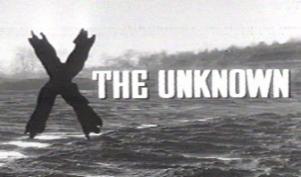

We've
all got a movie like this hiding in our childhood; we remember a scene
or two out of it, and that is really all we carry with us into adulthood.
I remember two scenes from X the Unknown, and they are scenes
that scared the living daylights out of the 9 year-old Freex. Upon finally
obtaining a copy of this movie after a lengthy search, I find that these
two scenes - and we'll get to them soon enough - still stir up a tingle,
although they now seem rather quaint, over forty years after
the fact.
We
start in a muddy field somewhere in Scotland, as British soldiers run
through a training exercise with Geiger counters. The sergeant (Hammer
regular Michael Ripper) buries an isotope, and each soldier tries to
find it, using the counter, in the shortest possible time. All goes
well, until the last soldier goes off in the wrongest direction possible;
he's found a powerful radiation reading in a section of the field where
there should be none.
As
his superiors argue about what to do in this situation, there is a small
earthquake and a fissure opens in the field. The wayward soldier, and
one of his fellows sent to retrieve him, are both burned terribly by
radiation - and then the radiation disappears.
Cut
to a nearby atomic research lab, where the administrator, Elliot (Edward
Chapman) is on the warpath. Not only has his star scientist and troublemaker
left his normal duties to work on his own project, but left Elliot's
son, Peter (William Lucas) in charge. Peter, you see, wants to be a
scientist, but Elliot wants his son to be a bean counter, just like
Daddy. The troublemaker in question, Royston (Dean Jagger), is in his
private workshop, working with an Erector set device that pulls a dangerous
isotope out of its lead box and suspends it between two radar dishes.
Alas, whatever he is doing is not working, and Royston's disgust shows.
His mood does not improve when a messenger arrives and tells him Elliot
wants to see him.
After
the required dressing-down, Elliot sends Royston to the field to help
the Army with its investigation. Though the radiation, once severe enough
to burn the impression of a soldier's gun into his back, is now completely
missing, Royston sets up sensors along the fissure. All he discovers,
however, is that the crack is apparently bottomless. He advises the
Major in charge to rope off the fissure and set a couple of guards,
and then everybody goes home for the night.
Well,
not everybody. Two young boys are out in the woods late at night, having
dared each other 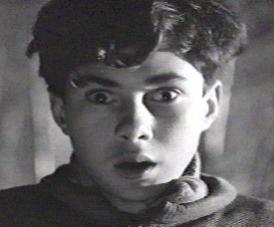 to
check on the old hermit who lives in a nearby abandoned tower. The braver
of the boys sneaks toward the tower, but sees something slithering
toward him; in terror, the boy runs all the way back to town, the other
boy in hot pursuit. to
check on the old hermit who lives in a nearby abandoned tower. The braver
of the boys sneaks toward the tower, but sees something slithering
toward him; in terror, the boy runs all the way back to town, the other
boy in hot pursuit.
The
next day, Royston arrives at the local hospital to examine the boy,
who is suffering from severe radiation poisoning. Investigating at the
tower, Royston finds not only the hermit and his still, but the isotope
container from Royston's own workshop. The fact that it has wound
up in the hermit's junk collection is astounding enough to Royston -
let alone the fact that the isotope should have killed the hermit in
the time he's possessed it.
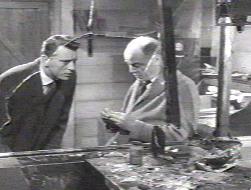 Royston
goes to his workshop, only to find it a shambles - someone or something
has wrecked the lab to get at the isotope - though whatever it was left
the door locked and windows intact. The only clue left behind was a
slimy substance covering everything. Royston tells the ever-attentive
Peter that he found the stuff covering his purloined container, too. Royston
goes to his workshop, only to find it a shambles - someone or something
has wrecked the lab to get at the isotope - though whatever it was left
the door locked and windows intact. The only clue left behind was a
slimy substance covering everything. Royston tells the ever-attentive
Peter that he found the stuff covering his purloined container, too.
The
UK equivalent of the Atomic Energy Commission sends one of their inspectors,
McGill (Leo McKern) at Elliot's request. Rather to the administrator's
consternation, however, McGill and Royston hit it off rather well. As
the two men arrive at the hospital to examine the boy, they find they
are too late - the lad has succumbed to the radiation. The boy's father
confronts Royston, telling him his son's death is the fault of all scientists..."setting
off bombs you can't control!" (the mandatory Amity Beach scene).
As they leave, the hospital's 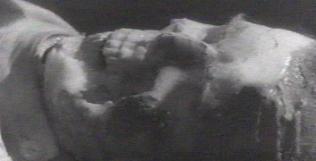 radiologist
has a rendezvous in his lab with a pretty young nurse...but they are
interrupted when his equipment indicates there's radiation in a room
where there should be none. Leaving the nurse in the lead-lined safety
room, he goes out to investigate, then screams...as the radiation from
the intruder causes him to melt before the nurse's horrified
eyes. radiologist
has a rendezvous in his lab with a pretty young nurse...but they are
interrupted when his equipment indicates there's radiation in a room
where there should be none. Leaving the nurse in the lead-lined safety
room, he goes out to investigate, then screams...as the radiation from
the intruder causes him to melt before the nurse's horrified
eyes.
Royston
and McGill come back to find a huge hole burned into the radiation lab's
radium vault - and, of course, the radium gone. The air duct leading
into the room has a slimy black substance on it. And the nurse is no
help, having gone not-so-quietly insane. Royston reveals his theory
to McGill, Peter and a skeptical Elliot: the Earth began as a mass of
molten matter, cooling down over a period of millions of years to a
life-supporting state. Man evolved into a dominant life form in only
a hundred thousand years - isn't it possible that some of that original,
primordial matter, might have developed some form of life over the million
of years it's been in existence?
Yes,
our villain is a metric ton or so of sentient, radioactive mud,
and it makes short work of the 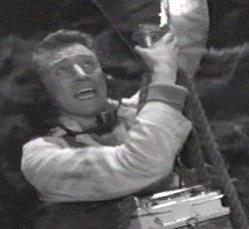 guards
posted at the fissure. Peter, being our young, reckless character, volunteers
to go down the fissure in a sling to verify Royston's theory. After
Peter finds the skeletal remains of one of the guards on a ledge, his
Geiger counter begins to go crazy. Peter looks down and begins to shriek,
"Pull me up! PULL ME UP!!!" This is one of the scenes
that got burned into my mind as a child. Don't worry, Peter gets hoisted
back up, safe and sound. The Army was only waiting for proof that something
was actually down there, and they proceed to swing into action, directing
flamethrowers and bombs down into the fissure, finally sealing the earthen
crack with cement. Royston is skeptical of the efficacy of this exercise;
frankly, so are we. guards
posted at the fissure. Peter, being our young, reckless character, volunteers
to go down the fissure in a sling to verify Royston's theory. After
Peter finds the skeletal remains of one of the guards on a ledge, his
Geiger counter begins to go crazy. Peter looks down and begins to shriek,
"Pull me up! PULL ME UP!!!" This is one of the scenes
that got burned into my mind as a child. Don't worry, Peter gets hoisted
back up, safe and sound. The Army was only waiting for proof that something
was actually down there, and they proceed to swing into action, directing
flamethrowers and bombs down into the fissure, finally sealing the earthen
crack with cement. Royston is skeptical of the efficacy of this exercise;
frankly, so are we.
McGill
comes to Royston's rebuilt workshop to say goodbye - his superiors feel
that the menace 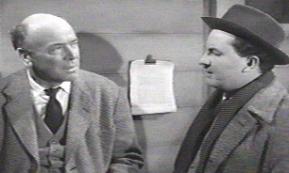 is
over, and have recalled him to London. Royston explains to him (and
finally to us) the purpose of his experiment with the isotope and the
dishes: he is seeking a method to stabilize radioactive materials, to
draw out their destructive energy in a passive way. In short, he's trying
to find a way to make nuclear bombs inoperative (a nice bit of irony,
considering the earlier Amity beach scene). Meantime, a crack develops
in the cement covering the fissure, and a black substance oozes out... is
over, and have recalled him to London. Royston explains to him (and
finally to us) the purpose of his experiment with the isotope and the
dishes: he is seeking a method to stabilize radioactive materials, to
draw out their destructive energy in a passive way. In short, he's trying
to find a way to make nuclear bombs inoperative (a nice bit of irony,
considering the earlier Amity beach scene). Meantime, a crack develops
in the cement covering the fissure, and a black substance oozes out...
McGill's
exit is forestalled by a police report of a car wreck with the occupants
not merely killed, 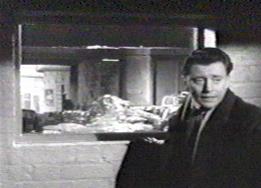 but
melted. Royston hurriedly shuts down the lab's atomic pile and
tries to evacuate the cobalt to a safer location, but the mud has gotten
bigger and faster, and makes a tasty snack of the fuel. The mud returns
to its fissure, and the Army sets up a giant version of Royston's experiment
on the beastie's doorstep. After luring it out with an isotope mounted
on a Jeep, the dishes zap it with the frequencies that Royston discovered
in the nick of time, causing the blob to glow and pulsate dramatically,
finally disappearing in a fiery, smoky foof. The end. but
melted. Royston hurriedly shuts down the lab's atomic pile and
tries to evacuate the cobalt to a safer location, but the mud has gotten
bigger and faster, and makes a tasty snack of the fuel. The mud returns
to its fissure, and the Army sets up a giant version of Royston's experiment
on the beastie's doorstep. After luring it out with an isotope mounted
on a Jeep, the dishes zap it with the frequencies that Royston discovered
in the nick of time, causing the blob to glow and pulsate dramatically,
finally disappearing in a fiery, smoky foof. The end.
After
the success of the first Quatermass movie, The Quatermass Xperiment
(known stateside as The Creeping Unknown) Hammer wanted to rush
out a sequel, but were stopped by author Nigel Kneale denying any unauthorized
use of his character. So Hammer produced a Quatermass-esque movie instead,
featuring the first script by then-production manager Jimmy Sangster.
In
X the Unknown, we see a lot of the tropes that Sangster will
employ again, later in his career, when he has a tighter grip on dialogue
and character: the two boys out on a dare, in particular, is a classic
Sangster plot device. As X returns from it's feasting on the cobalt
core, it is detoured from its return to the fissure by fallen high-voltage
wires, causing it to travel through a village; the villagers have been
evacuated to the local church, but as the doors swing shut, the camera
pans down to reveal that a little girl, perhaps only two years old,
has remained outside. Practically the same moment exists in the Sangster-scripted
The Crawling Eye.
This is the second scene that has remained filed in my brain all these
years, and I think it was this one that actually caused me to leave
the room. Had I stuck around, I would have seen the priest snatch the
little girl away from the path of X - but then, I probably would have
wondered why they didn't melt, so it's just as well. That little
point excepted, the script is still nicely polished for a first attempt.
The
cast is the usual assemblage of dependable Brit talent, with Dean Jagger
in apparently as a hook for American audiences. The Oscar-winning Jagger
puts in an interesting, if sometimes detached performance; as ever,
it's the little things that make a role like this. Royston uses a cane
although he seems to have no difficulty in walking, and although every
man in the cast wears a snap-brim hat (except the youthful Peter), Royston
always dons a stocking cap when he goes outside - the character is more
concerned with comfort than appearance.
Depending
on your upbringing, you will either be more familiar with Leo McKern
as the archeologist who knows way too much about the Antichrist in The
Omen or the only Number 2 to get more than one turn at bat in The
Prisoner TV series (after publishing that sentence, Brandi Weed
pointed out that another Number 2 appeared twice - Colin Gordon
- and that most people would probably recognize McKern as Rumpole
of the Bailey. Right both times, and thank you, Brandi). A fine
character actor, McKern isn't given much of a chance to strut his stuff
here, but does a good, solid turn - frankly, I would have preferred
to see him in the role of Royston.
And
you know how I am always rooting for the Comic Relief to wind up on
the wrong end of the 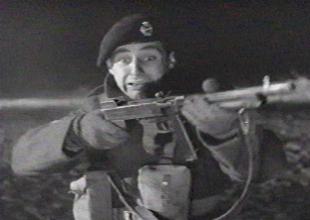 monster?
In X the Unknown it happens- the two guards left on the fissure
have regaled us through the picture with their comedy stylings (and
they might actually be funny, but their accents are a bit impenetrable
to these Yank ears. Another viewing is called for) and they run into
the blob with predictable results. Musical theater and Eastender
fans will want to note that one of the ill-fated soldiers is a young
Anthony Newley, and I should mention that the gloriously-named Scots
guard. Cpl. Haggis, is Ian MacNaughton, later a producer and director
for Monty Python's Flying Circus. monster?
In X the Unknown it happens- the two guards left on the fissure
have regaled us through the picture with their comedy stylings (and
they might actually be funny, but their accents are a bit impenetrable
to these Yank ears. Another viewing is called for) and they run into
the blob with predictable results. Musical theater and Eastender
fans will want to note that one of the ill-fated soldiers is a young
Anthony Newley, and I should mention that the gloriously-named Scots
guard. Cpl. Haggis, is Ian MacNaughton, later a producer and director
for Monty Python's Flying Circus.
Once
again, Hammer is dealing with a next-to-nothing budget, and for the
most part, does it well - one of the advantages of having your production
manager write the script. The beastie is not seen until the final third
of the picture, and then the blob effects are done extremely well (two
years before the Steve McQueen Blob, no less). There are a couple
of scene with miniatures that show dime-store origins, but they are
mercifully brief.
I
have mentioned before that I am a big fan of Nigel Kneale in general
and his Quatermass films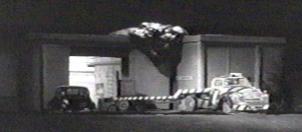 in particular - thoughtful, logical mixtures of science-fiction and
horror that are all too rare. Even imitators of the form, like X
the Unknown and Prince
of Darkness exude an intelligence in a genre that too often
substitutes flash and thunder for brains; they do not particularly challenge
your intelligence, but they at least assume that you have some.
in particular - thoughtful, logical mixtures of science-fiction and
horror that are all too rare. Even imitators of the form, like X
the Unknown and Prince
of Darkness exude an intelligence in a genre that too often
substitutes flash and thunder for brains; they do not particularly challenge
your intelligence, but they at least assume that you have some.
Thus
these movies are my friends; and I am theirs.
|